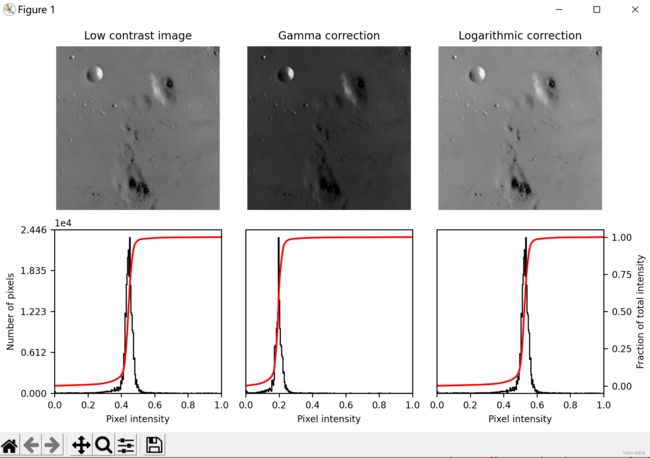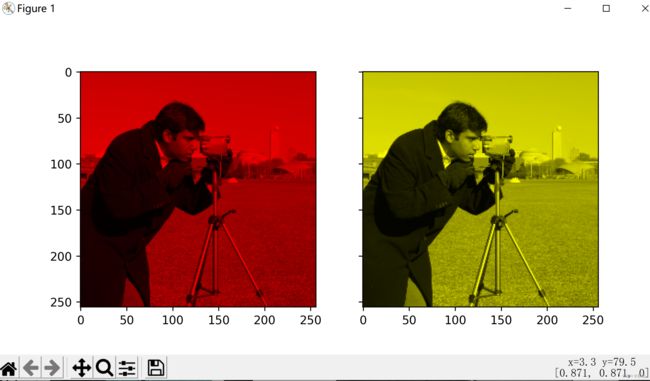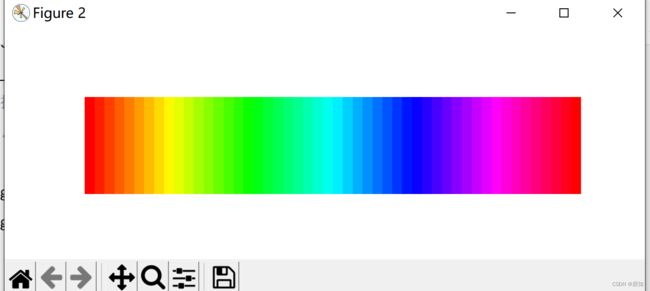skimage学习(3)——Gamma 和 log对比度调整、直方图均衡、为灰度图像着色
1、Gamma 和 log对比度调整
本示例通过对输入图像进行伽马和对数校正来调整图像对比度。
import matplotlib
import matplotlib.pyplot as plt
import numpy as np
from skimage import data, img_as_float
from skimage import exposure
matplotlib.rcParams['font.size'] = 8
def plot_img_and_hist(image, axes, bins=256):
#绘制图像及其直方图和累积直方图。
image = img_as_float(image)#转换为浮点型
ax_img, ax_hist = axes # axes为2行3列图块,第一行为ax_img ,第二行为ax_hist
ax_cdf = ax_hist.twinx() #twinx()函数表示共享x轴 twiny()表示共享y轴 共享表示的就是第二行所有坐标系的x轴使用同一刻度线
# Display image
ax_img.imshow(image, cmap=plt.cm.gray)
ax_img.set_axis_off()
'''
Cmap是MATLAB里面用来设定和获取当前色图的函数,可以设置如下色图:
hot 从黑平滑过度到红、橙色和黄色的背景色,然后到白色。
cool 包含青绿色和品红色的阴影色。从青绿色平滑变化到品红色。
gray 返回线性灰度色图。
bone 具有较高的蓝色成分的灰度色图。该色图用于对灰度图添加电子的视图。
white 全白的单色色图。
spring 包含品红和黄的阴影颜色。
summer 包含绿和黄的阴影颜色。
autumn 从红色平滑变化到橙色,然后到黄色。
winter 包含蓝和绿的阴影色。
'''
# Display histogram
ax_hist.hist(image.ravel(), bins=bins, histtype='step', color='black')
# bins 为直方图的柱数 image.ravel() 将矩阵拉伸成一维数组
# histtype: 直方图类型,‘bar’, ‘barstacked’, ‘step’, ‘stepfilled’
ax_hist.ticklabel_format(axis='y', style='scientific', scilimits=(0, 0))
# 设置y轴
# sytle: sci或scientific 科学计数法 plain:自然数
# sclimits (m, n) 轴的值范围 10的m次方 to 10的n次方 (0,0)表示无限制
ax_hist.set_xlabel('Pixel intensity')##设置 x轴标签:像素强度
ax_hist.set_xlim(0, 1)#设置x轴范围0到1
ax_hist.set_yticks([])
# set_xticks 与 set_yticks 方法可以显示地设置标号的位置
# ax.set_xticks([0.25, 0.5, 0.75])
# ax.set_xticklabels(['a', 'b', 'c'], fontsize=18)
# Display cumulative distribution
# 返回给定图像的累积分布函数(cdf) mg_cdf:数组累积分布函数的值。bin_centers:数组中心。
img_cdf, bins = exposure.cumulative_distribution(image, bins)
ax_cdf.plot(bins, img_cdf, 'r')
ax_cdf.set_yticks([])
return ax_img, ax_hist, ax_cdf
# Load an example image
img = data.moon()
# Gamma
gamma_corrected = exposure.adjust_gamma(img, 2)
'''
图像亮度与对比度的调整,是放在skimage包的exposure模块里面
gamma调整
原理:I=Ig
对原图像的像素,进行幂运算,得到新的像素值。公式中的g就是gamma值。
如果gamma>1, 新图像比原图像暗
如果gamma<1,新图像比原图像亮
函数格式为:skimage.exposure.adjust_gamma(image, gamma=1)
gamma参数默认为1,原像不发生变化 。
伽马变换对于图像对比度偏低,并且整体亮度值偏高(对于于相机过曝)情况下的图像增强效果明显。
'''
# 对数
logarithmic_corrected = exposure.adjust_log(img, 1)
'''
log 函数的表达式:
y=alog(1+x), a 是一个放大系数,x 同样是输入的像素值,取值范围为 [0−1], y 是输出的像素值。
对数变换对于整体对比度偏低并且灰度值偏低的图像增强效果较好。
'''
# 显示结果
fig = plt.figure(figsize=(8, 5))
axes = np.zeros((2, 3), dtype=np.object)#axes两行三列值为0
axes[0, 0] = plt.subplot(2, 3, 1)
axes[0, 1] = plt.subplot(2, 3, 2, sharex=axes[0, 0], sharey=axes[0, 0])
axes[0, 2] = plt.subplot(2, 3, 3, sharex=axes[0, 0], sharey=axes[0, 0])
axes[1, 0] = plt.subplot(2, 3, 4)
axes[1, 1] = plt.subplot(2, 3, 5)
axes[1, 2] = plt.subplot(2, 3, 6)
ax_img, ax_hist, ax_cdf = plot_img_and_hist(img, axes[:, 0])#画布的第一列
ax_img.set_title('Low contrast image')#低对比度图像
y_min, y_max = ax_hist.get_ylim()
ax_hist.set_ylabel('Number of pixels')#像素的数量
ax_hist.set_yticks(np.linspace(0, y_max, 5))#y轴5等分,标记等分数值
ax_img, ax_hist, ax_cdf = plot_img_and_hist(gamma_corrected, axes[:, 1])
ax_img.set_title('Gamma correction')#伽马修正
ax_img, ax_hist, ax_cdf = plot_img_and_hist(logarithmic_corrected, axes[:, 2])
ax_img.set_title('Logarithmic correction')#对数修正
ax_cdf.set_ylabel('Fraction of total intensity')#总强度百分数
ax_cdf.set_yticks(np.linspace(0, 1, 5))#设置y轴标签
# prevent overlap of y-axis labels
fig.tight_layout()
plt.show()
2、直方图均衡
此示例使用称为直方图均衡的方法增强了低对比度的图像,该方法 在图像1中“展开最频繁的强度值” 。均衡后的图像具有大致线性的累积分布函数。
虽然直方图均衡具有不需要参数的优点,但有时会产生看起来不自然的图像。另一种方法是 对比度拉伸,其中图像被重新缩放以包括落在第 2 和第 98 个百分位数内的所有强度。
import matplotlib
import matplotlib.pyplot as plt
import numpy as np
from skimage import data, img_as_float
from skimage import exposure
matplotlib.rcParams['font.size'] = 8
def plot_img_and_hist(image, axes, bins=256):
"""绘制图像及其直方图和累积直方图。
"""
image = img_as_float(image)
ax_img, ax_hist = axes
ax_cdf = ax_hist.twinx()
# 展示图片
ax_img.imshow(image, cmap=plt.cm.gray)
ax_img.set_axis_off()
# 显示柱状图
ax_hist.hist(image.ravel(), bins=bins, histtype='step', color='black')
ax_hist.ticklabel_format(axis='y', style='scientific', scilimits=(0, 0))
ax_hist.set_xlabel('Pixel intensity')
ax_hist.set_xlim(0, 1)
ax_hist.set_yticks([])
# 显示累积分布
img_cdf, bins = exposure.cumulative_distribution(image, bins)
ax_cdf.plot(bins, img_cdf, 'r')
ax_cdf.set_yticks([])
return ax_img, ax_hist, ax_cdf
# 加载一个示例图片
img = data.moon()
# 对比度拉伸,对比度拉伸是图像增强的一种方法,也属于灰度变换操作
p2, p98 = np.percentile(img, (2, 98))#要计算的(2,98)数序列。计算沿指定轴的数据的第q个百分位数
img_rescale = exposure.rescale_intensity(img, in_range=(p2, p98))#原始像素值不想被拉伸,只是等比例缩小
'''
numpy.percentile:https://www.cjavapy.com/article/1087/
exposure.rescale_intensity:https://blog.csdn.net/PresleyR/article/details/116200390
'''
# 均衡
img_eq = exposure.equalize_hist(img)
# 自适应均衡
img_adapteq = exposure.equalize_adapthist(img, clip_limit=0.03)
# 显示结果
fig = plt.figure(figsize=(8, 5))
axes = np.zeros((2, 4), dtype=np.object)
axes[0, 0] = fig.add_subplot(2, 4, 1)
for i in range(1, 4):
axes[0, i] = fig.add_subplot(2, 4, 1+i, sharex=axes[0,0], sharey=axes[0,0])
for i in range(0, 4):
axes[1, i] = fig.add_subplot(2, 4, 5+i)
ax_img, ax_hist, ax_cdf = plot_img_and_hist(img, axes[:, 0])
ax_img.set_title('Low contrast image')
y_min, y_max = ax_hist.get_ylim()
ax_hist.set_ylabel('Number of pixels')
ax_hist.set_yticks(np.linspace(0, y_max, 5))
ax_img, ax_hist, ax_cdf = plot_img_and_hist(img_rescale, axes[:, 1])
ax_img.set_title('Contrast stretching')#对比度拉伸
ax_img, ax_hist, ax_cdf = plot_img_and_hist(img_eq, axes[:, 2])
ax_img.set_title('Histogram equalization')#直方图均衡化
ax_img, ax_hist, ax_cdf = plot_img_and_hist(img_adapteq, axes[:, 3])
ax_img.set_title('Adaptive equalization')#自适应均衡
ax_cdf.set_ylabel('Fraction of total intensity')#总强度的分数
ax_cdf.set_yticks(np.linspace(0, 1, 5))
# 防止y轴标签重叠
fig.tight_layout()
plt.show()
3、为灰度图像着色
用某种颜色人为地给图像着色是很有用的,既可以突出图像的特定区域,也可以使灰度图像生动起来。
这个例子通过缩放RGB值和在HSV颜色空间中调整颜色来演示图像着色。
在2D中,彩色图像通常用2D数组的RGB-3层表示,这3层表示图像的®ed、(G) green和(B)lue通道。
获得着色图像的最简单方法是将每个RGB通道设置为通过每个通道的不同乘数缩放的灰度图像。
'''
例如,将绿色和蓝色通道乘以0只会留下红色通道并产生明亮的红色图像。
同样,将蓝色通道归零,只留下红色和绿色通道,它们结合起来就形成黄色通道。
'''
import matplotlib.pyplot as plt
from skimage import data
from skimage import color
from skimage import img_as_float
grayscale_image = img_as_float(data.camera()[::2, ::2])#浮点型灰度图
image = color.gray2rgb(grayscale_image)#创建灰度图像的RGB表示。
red_multiplier = [1, 0, 0]
yellow_multiplier = [1, 1, 0]
fig, (ax1, ax2) = plt.subplots(ncols=2, figsize=(8, 4),
sharex=True, sharey=True)
ax1.imshow(red_multiplier * image)#将绿色和蓝色通道乘以0只会留下红色通道并产生明亮的红色图像
ax2.imshow(yellow_multiplier * image)#将蓝色通道归零,只留下红色和绿色通道,它们结合起来就形成黄色通道
'''
在许多情况下,处理RGB值可能并不理想。正因为如此,有许多其他颜色空间可以用来表示彩色图像。
一个流行的颜色空间叫做HSV,它代表色相(~颜色)、饱和度(~色彩度)和值(~亮度)。
例如,一种颜色(色调)可能是绿色,但它的饱和度是绿色的强度——橄榄色在低端,霓虹灯在高端。
在某些实现中,HSV中的色调从0到360,因为色调环绕在一个圆圈中。
然而,在scikit-image中,色调是从0到1的浮动值,因此色调、饱和度和值共享相同的尺度。
下面,我们在色调中绘制了一个线性梯度,饱和度和值一路上升:
'''
import numpy as np
hue_gradient = np.linspace(0, 1)#再0、1之间生成长度为50的数组
hsv = np.ones(shape=(1, len(hue_gradient), 3), dtype=float)#返回长为1,宽为50,高为3的数组
hsv[:, :, 0] = hue_gradient
all_hues = color.hsv2rgb(hsv)#创建灰度图像的RGB表示
fig, ax = plt.subplots(figsize=(5, 2))
# 设置图像范围,使色调从0到1,图像是一个很好的长宽比。
ax.imshow(all_hues, extent=(0 - 0.5 / len(hue_gradient),
1 + 0.5 / len(hue_gradient), 0, 0.2))
ax.set_axis_off()
'''
创建一个小实用函数来获取 RGB 图像,并且:
1. 将 RGB 图像转换为 HSV
2. 设置色调和饱和度
3. 将 HSV 图像转换回 RGB
'''
def colorize(image, hue, saturation=1):
""" 将给定色调的颜色添加到RGB图像中。
默认情况下,饱和度设置为1,以便颜色弹出!
"""
hsv = color.rgb2hsv(image)
hsv[:, :, 1] = saturation#饱和度(S)
hsv[:, :, 0] = hue#色调(H)
return color.hsv2rgb(hsv)
'''
请注意,我们需要提高饱和度;饱和度为零的图像是灰度的,所以我们需要一个非零值才能真正看到我们设置的颜色。
使用上面的函数,我们绘制了六个具有线性渐变色调和非零饱和度的图像:
'''
hue_rotations = np.linspace(0, 1, 7)#返回长度为6,在0、1之间均分的数组
fig, axes = plt.subplots(nrows=2, ncols=3, sharex=True, sharey=True)
for ax, hue in zip(axes.flat, hue_rotations):
# Turn down the saturation to give it that vintage look.
tinted_image = colorize(image, hue, saturation=0.3)#饱和度为0.3,hue=hue_rotations
ax.imshow(tinted_image, vmin=0, vmax=1)
ax.set_axis_off()
fig.tight_layout()
'''
将此着色效果与 numpy 切片和精美索引相结合,以选择性地为您的图像着色。
在下面的示例中,我们使用切片设置一些矩形的色调,并缩放通过阈值处理找到的一些像素的 RGB 值。
在实践中,您可能希望根据分割结果或斑点检测方法定义一个着色区域。
'''
from skimage.filters import rank
# 在前两个维度上定义为切片的正方形区域。
top_left = (slice(25),) * 2#slice()函数实现切片对象,x轴和y轴
bottom_right = (slice(-25, None),) * 2
print("top_left:",top_left)
print("bottom_right:",bottom_right)
#top_left: (slice(None, 25, None), slice(None, 25, None))
#bottom_right: (slice(-25, None, None), slice(-25, None, None))
sliced_image = image.copy()
sliced_image[top_left] = colorize(image[top_left], 0.82, saturation=0.5)#切片染色
sliced_image[bottom_right] = colorize(image[bottom_right], 0.5, saturation=0.5)
# 创建一个蒙版选择区域与有趣的纹理。
noisy = rank.entropy(grayscale_image, np.ones((9, 9)))
'''
skimage.filters.rank.entropy(image,footprint,out = None,mask = None,shift_x = False,shift_y = False,shift_z = False)
熵使用以 2 为底的对数计算,即滤波器返回对局部灰度分布进行编码所需的最小位数
参数:
1、image([P,] M, N) ndarray (uint8, uint16)
输入图像。
2、footprint:ndarray
邻域表示为 1 和 0 的 ndarray。
3、out ([P,] M, N) 数组(与输入相同的 dtype)
如果没有,则分配一个新数组。
4、mask:ndarray(整数或浮点数),可选
定义包含在本地邻域中的图像的 (>0) 区域的掩码数组。如果没有,则使用完整的图像(默认)。
5、shift_x, shift_y, shift_z int
添加到封装中心点的偏移量。Shift 受限于封装尺寸(中心必须在给定封装内)。
返回值:
out ([P,] M, N) ndarray (float)
输出图像。
'''
textured_regions = noisy > 4.25#筛选,和text_3的用法相似
'''
注意在这里使用colorize有点困难,因为使用rgb2hsv
期望一个RGB图像(高度x宽度x通道),但变址的索引返回
一组RGB像素(# pixels x channel)。
'''
masked_image = image.copy()
masked_image[textured_regions, :] *= red_multiplier
#我猜,这边的意思应该是按照一定的规律把灰度图像的部分范围制红
fig, (ax1, ax2) = plt.subplots(ncols=2, nrows=1, figsize=(8, 4),
sharex=True, sharey=True)
ax1.imshow(sliced_image)
ax2.imshow(masked_image)
plt.show()



